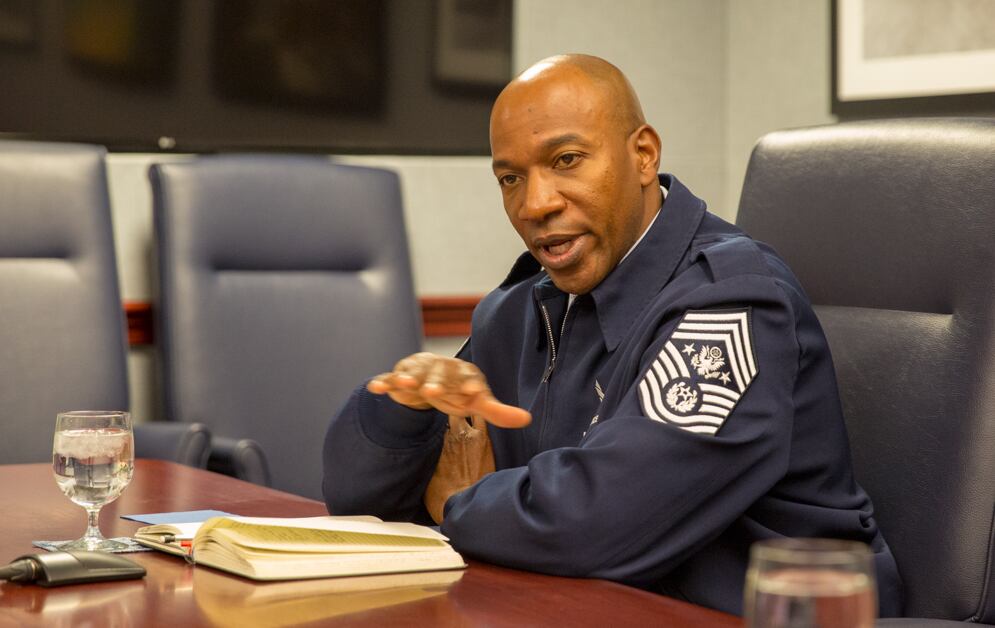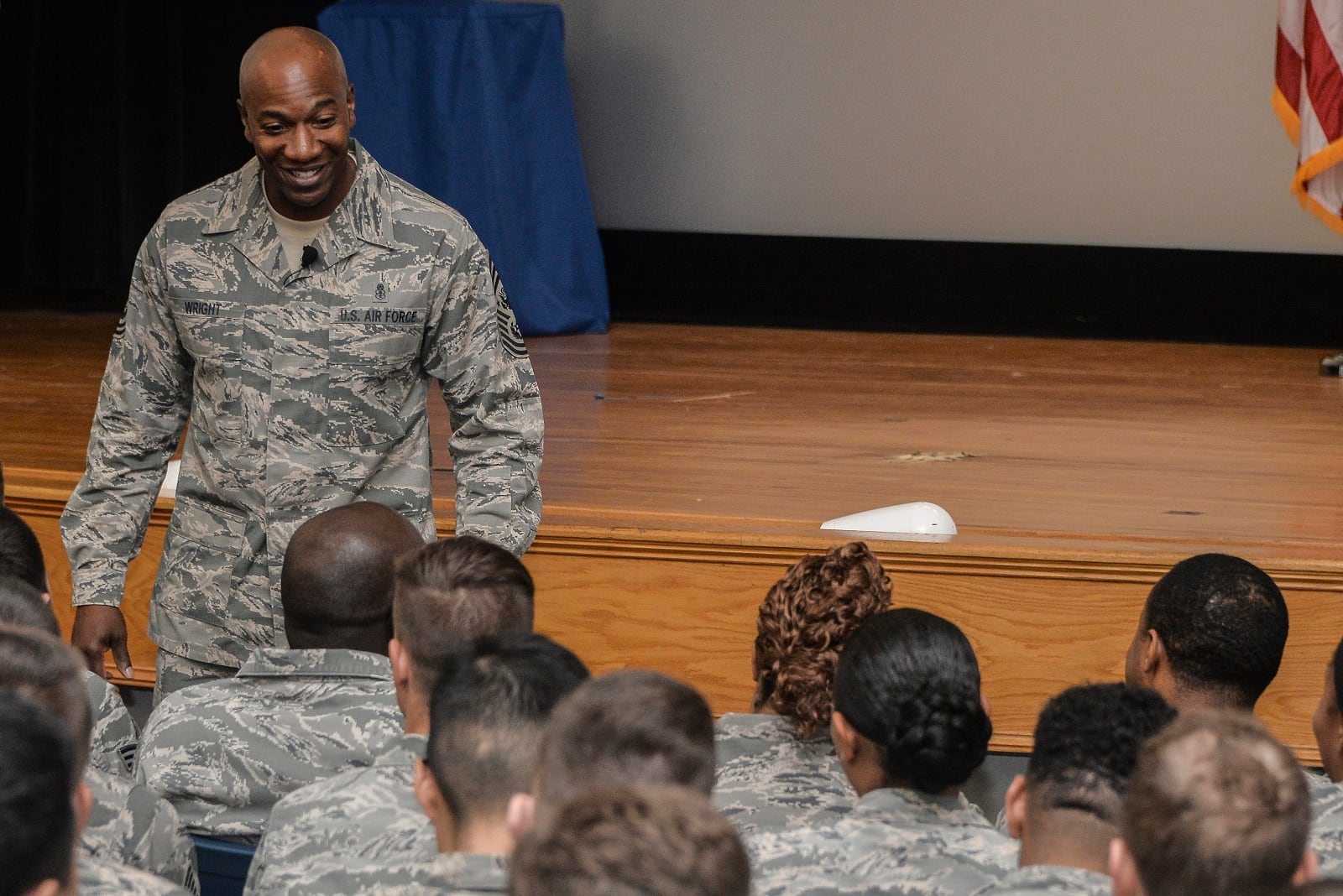In his first year and a half on the job, Chief Master Sergeant of the Air Force Kaleth Wright has been a driving force behind many changes that have improved airmen’s lives — and drawn cheers from many.
Wright has helped push the Air Force to adopt the new OCP uniform, slash unnecessary rules, training and additional duties, eliminate enlisted performance reports for airmen first class, and change professional military education. And his willingness to root out nagging problems that frustrate airmen day to day — as well as his lighthearted, social media-friendly presence — have earned him a fan base online and for some, the tongue-in-cheek nickname “Enlisted Jesus.”
In an Aug. 15 interview, Wright said those “small wins” over the past year have helped increase morale among enlisted airmen and build trust in himself and other Air Force leaders.
And in the coming year, Wright said he’s planning to build on the progress made.
High year of tenure
Atop his list is extending the current high year of tenure rules so airmen can stay in longer without getting promoted. Currently, staff sergeants have to get out at 15 years if they don’t get promoted to technical sergeant. But in July, Wright voiced his support for extending the so-called up-or-out rules for E-5s to 20 years. He also said in July that the Air Force is considering extending tech sergeants' high year of tenure from 20 to 22 years, as well as extending senior airmen’s current eight-year high year of tenure.
In the interview, Wright said the Air Force is “really close” on a decision on high year of tenure, and said he wants to get it “across the finish line” sometime in September — though he cautioned there are no guarantees.
Indefinite re-enlistments
Wright also expects an announcement on moving to an indefinite enlistment system — in which senior non-commissioned officers would automatically be re-enlisted until they decide to leave — sometime before the end of calendar year 2018.
The system — which would be similar to how the Army handles enlistments — could be structured something like this: Airmen who hit 15 years time-in-service would automatically have their enlistments extended to their rank’s high year of tenure mark. They could apply to retire once they became eligible, or separate before becoming retirement-eligible, as long as they don’t have an active-duty service commitment. Airmen who are promoted would have their service extended to their new rank’s high year of tenure.
“That stuff has become a priority for me, for our vice chief, for the chief of staff, for the senior leadership in the Air Force,” Wright said. “I think we’ll get there much faster.”

Dropping WAPS testing for SNCOs
And 2019 is likely to see a major change to how SNCOs are evaluated and promoted, Wright said. The Air Force is considering dropping the Weighted Airman Promotion System tests for promotion to master sergeant through chief master sergeant.
The Air Force has had WAPS testing since 1970, Wright said, but it might not be necessary for E-7 through E-9.
“We’re the only service that still tests senior NCOs for promotion,” Wright said. “I feel pretty confident in the board process, that we can select the right individuals without the WAPS test.”
The tests would not be replaced by anything, he said. The current SNCO board process would have enough information to decide who to promote by looking at their EPRs, board certifications and decorations.
“We have enough data to determine who’s ready for promotion at those grades,” Wright said. “I don’t feel like we need the test portion.”
But it’s not a done deal yet, Wright said. For example, the Air Force has to think through all the potential “second and third order” unintended effects of such a change before putting it into place.
Wright also said there might be some other tweaks to the board process, though the Air Force is largely happy with how it’s working.
The Air Force hasn’t yet looked at changes to the staff or tech sergeant promotion processes, but will start reviewing them early next year, he noted.
The Air Force last reformed its enlisted evaluation and promotion process in 2015. One major change put into place then was establishing a “forced distribution” system that used quotas to limit how many airmen could get the highest ratings, which was aimed at reducing the problem of runaway grade inflation.
Warrant officers
One thing that’s not likely to get resolved in 2019: the long-standing debate over whether the Air Force should bring back warrant officers.
“I doubt if we’ll see a decision next year,” Wright said. “We may, but I don’t think we’ve made enough progress [or] traction across our force to really make a decision on whether this is the right thing for our force. ... Me personally, I just don’t get the sense that as an Air Force, this is a step that we’re necessarily ready to make, that there’s enough support across the Air Force to implement this program.”
RELATED

Wright said he sees some benefits to bringing back warrant officers. But in other areas, the Air Force already uses its senior NCOs in some of the roles that warrant officers could fulfill.
And Wright said it’s not a question of needing more data on the subject — the Air Force probably has all the information it needs on warrant officers. But other issues have taken priority for Air Force leaders over the past year or so, he said.
When asked if the warrant officer debate is effectively dead in the Air Force, Wright said no.
“It’s probably something that we need to dust off, and come together as the senior leadership in the Air Force and make a decision on either, let’s go forward and do it, or let’s kill it, one or the other," Wright said. "But it’s not dead yet.”
Stephen Losey is the air warfare reporter for Defense News. He previously covered leadership and personnel issues at Air Force Times, and the Pentagon, special operations and air warfare at Military.com. He has traveled to the Middle East to cover U.S. Air Force operations.





